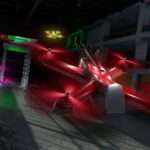Introduction: To optimize the flight performance of FPV (First Person View) drones, you need to consider propeller selection and blade angles. Choosing the right propellers for different flight styles will ensure that your drone performs as desired. In this article, we will examine how propeller selection and blade angles affect long-range, freestyle, racing, and other flight styles.
Propeller Selection and Its Impact on Flight Styles A. Propeller Selection for Long-Range Flights:
Long-range flights typically cover long distances and aim to maximize battery life. Factors to consider in propeller selection include:
High Efficiency: Battery life is crucial for long-range flights, so high-efficiency propellers should be preferred. Propellers that consume less power while providing higher thrust should be chosen.
Larger Propellers: Larger propellers can generate more thrust and offer longer flight times at lower RPM (revolutions per minute). Therefore, long-range drones typically use 5 inches or larger propellers.
Lower Pitch Angle: Propeller pitch angles should be lower. Lower pitch angles produce more thrust at lower RPMs, leading to energy savings.
Stability: Drone stability is important for long-range flights. Therefore, propellers that ensure stable flight should be chosen.
B. Propeller Selection and Blade Angles for Freestyle Flights: Freestyle flights involve creative flying with acrobatic maneuvers and fast maneuvers. Propeller selection and blade angles are important for this flight style:
High Thrust: Freestyle flights require high thrust for quick speed changes and maneuvers. Therefore, propellers that produce high thrust should be selected.
Smaller Propellers: Freestyle drones are often equipped with smaller propellers (e.g., 5 inches or smaller) for agile flying.
Negative Blade Angles (Reverse Pitch): Negative blade angles can be preferred for freestyle flights as they provide more lift for acrobatic maneuvers and enhance maneuverability.
Precise Control: Freestyle flights require precise directional control. Therefore, propellers should respond quickly and accurately to the drone’s desired directions.
C. Propeller Selection and Blade Angles for Racing Flights: Racing flights demand speed and agility. Propeller selection and blade angles are crucial for this competitive flight style:
Speed-Oriented: Speed is critical in racing flights. Propellers with high RPM are preferred to increase speed.
Smaller and Lightweight Propellers: Smaller and lighter propellers can facilitate higher speeds and enhance agility.
Negative Blade Angles (Reverse Pitch): Negative blade angles may be chosen for rapid turns during races.
Precise Directional Control: Racing drones require precise directional control, so propellers should enable fast and sharp turns.
D. Propeller Selection and Blade Angles for Other Flight Styles: Aerobatic Flights: During aerobatic flights, drones often perform maneuvers like spins, flips, and rolls. Blade angles should provide quick response and high thrust.
Sightseeing and Photography: For calm flights that require stable exposure, propellers that offer high efficiency and stable flight are preferred.
Delivery Flights: During delivery flights, propellers should be chosen based on the payload carried by the drone.
II. Blade Angles and Their Effects on Flight A. Flat Blades (0 Degrees): Flat blades mean that the propeller blades are parallel to the aircraft’s body. This is suitable for high-speed flights and races. Flat blades provide more thrust at higher RPMs and increase speed. However, they produce less lift, resulting in lower maneuverability.
B. Negative Blade Angle (Reverse Pitch): Negative blade angles mean that the propeller blades are inclined toward the aircraft’s body. This is suitable for freestyle flights as negative blades provide more lift and enhance maneuverability. They make it easier for the drone to perform quick turns and acrobatic maneuvers.
C. Positive Blade Angle (Reversed, Positive Pitch): Positive blade angles mean that the propeller blades are away from the aircraft’s body. This is suitable for long-range flights as positive blades provide more thrust and allow for more efficient flights at lower RPMs. Positive blades increase battery life but may reduce maneuverability.
D. Adjustable Blade Angles: Some drones have adjustable blade angles that allow you to optimize them according to your flight style and requirements. This is suitable for versatile drones as you can fine-tune blade angles based on your flight style.
III. Conclusion A. Suitability of Propeller Selection for Flight Styles: Propeller selection ensures that your drone performs optimally according to your flight style and goals.
B. Opportunity to Optimize Flight Performance: Choosing the right propellers allows your drone to fly with maximum efficiency and achieve the desired flight characteristics.
C. Importance of Propeller Selection Based on Flight Style and Preferences: Each flight style has different requirements, so choosing propellers based on your flight style and preferences is crucial.
D. Benefits of Flexible Blade Angle Options: Adjustable blade angles provide flexibility to adapt to various flight styles and optimize your drone accordingly.
This article has provided a detailed examination of the impact of propeller selection and blade angles on the flight performance of FPV drones. Choosing the right propellers based on your flight’s purpose and preferences is essential for achieving your desired flight experience. Specifically, negative blade angles may be preferred for freestyle flights, flat blades for speed-oriented flights, and positive blade angles for long-range flights. Additionally, the option of adjustable blade angles offers flexibility for accommodating various flight styles.












